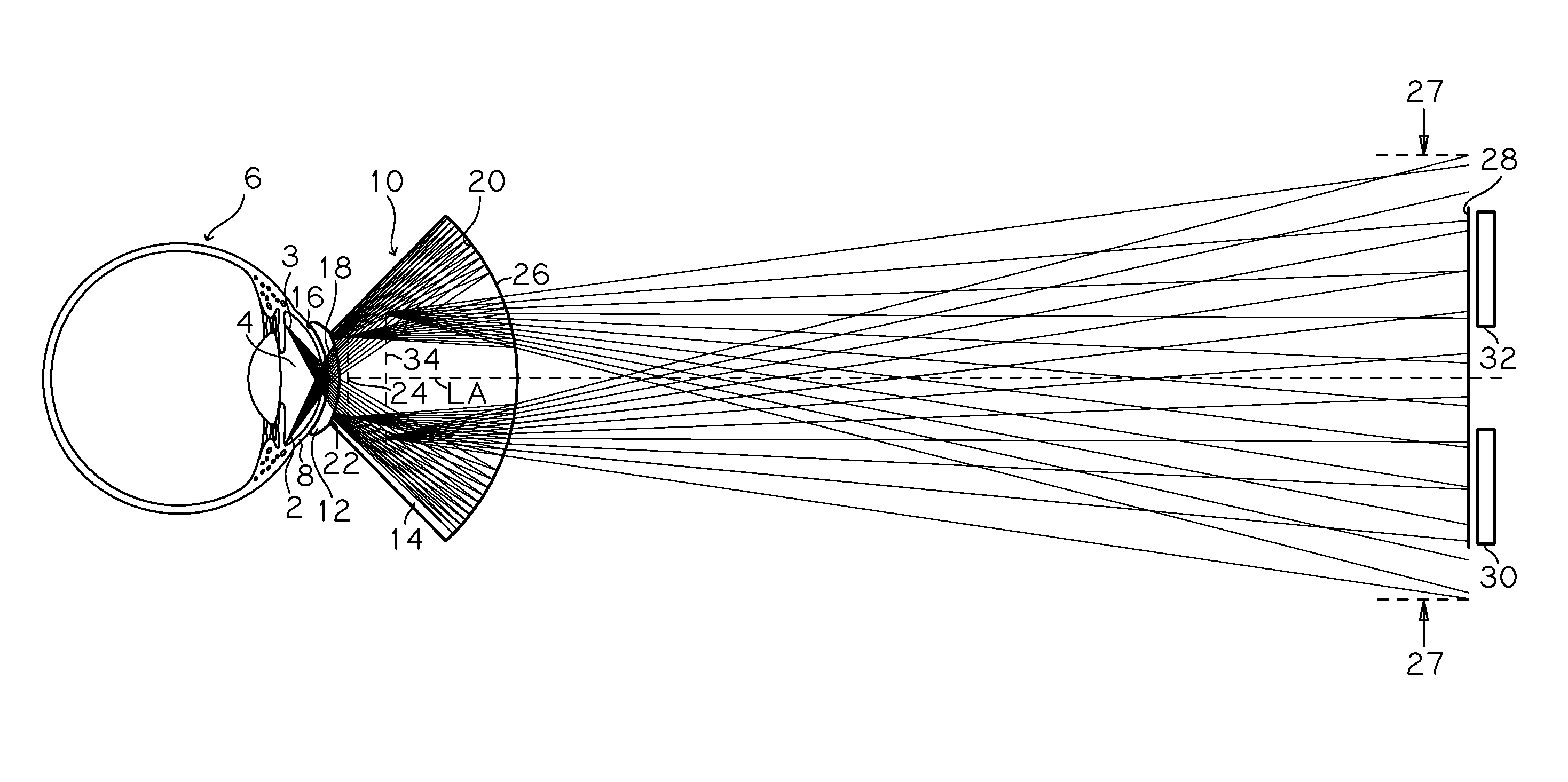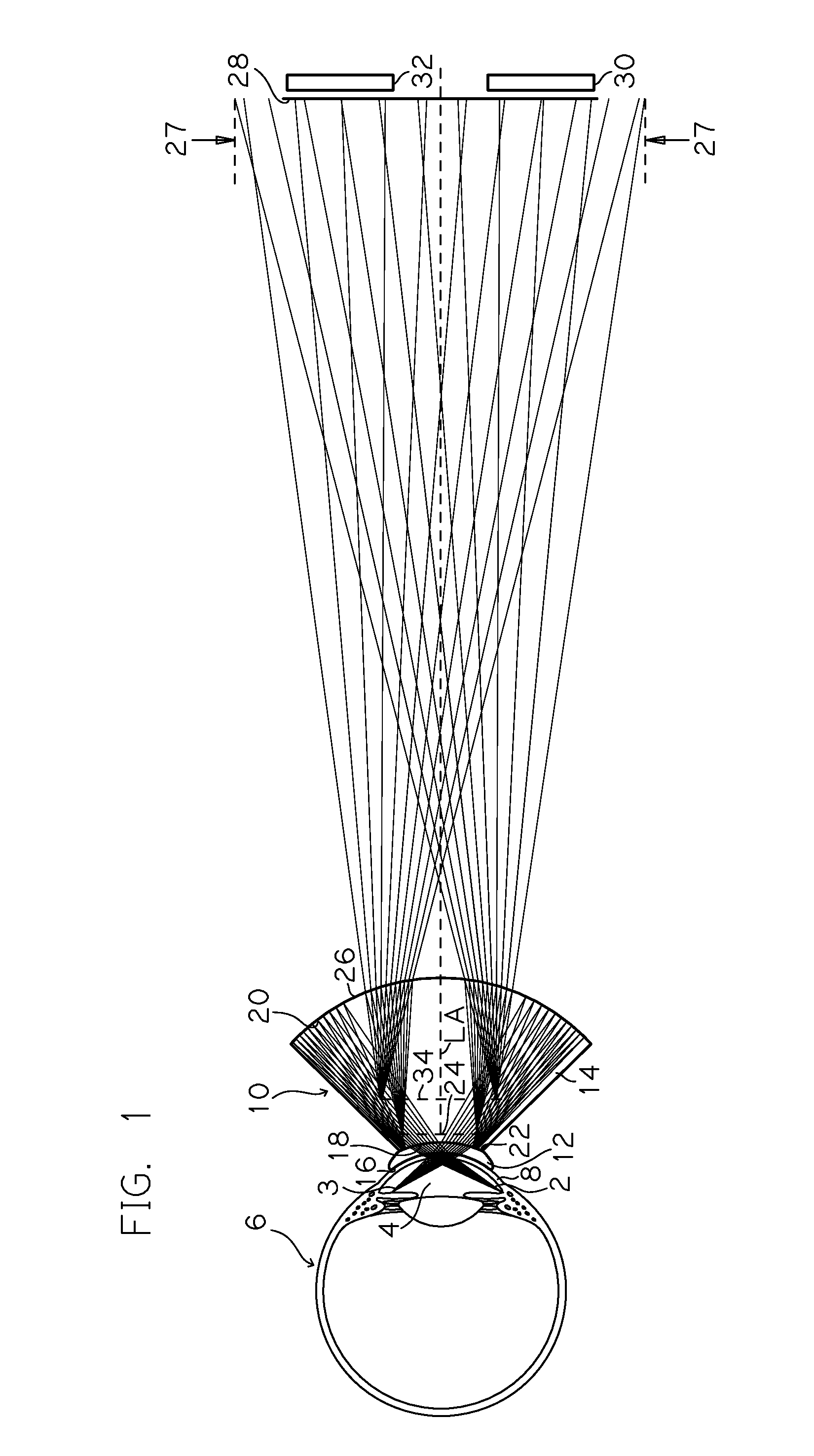Real image forming eye examination lens utilizing two reflecting surfaces with non-mirrored central viewing area
- Summary
- Abstract
- Description
- Claims
- Application Information
AI Technical Summary
Benefits of technology
Problems solved by technology
Method used
Image
Examples
first embodiment
[0067]Referring to FIG. 1, there is shown a ray tracing and schematic cross-sectional view of an exemplary doublet gonioscopy lens according to the invention, wherein lens 10 comprises an optically coupled lens including posterior contacting element 12 and anterior element 14. In this embodiment the anterior reflecting surface comprises an aspheric curvature and the posterior reflecting surface comprises a spherical curvature. Posterior element 12 is made of optical quality polymethylmethacrylate with an index of refraction of approximately Nd=1.492 and an Abbe number of approximately Vd=55.3, and anterior element 14 is made of S-LAH58 optical glass (available from Ohara Corp.) having an index of refraction of approximately Nd=1.883 and an Abbe number of approximately Vd=40.8. The two elements 12 and 14 are optically coupled at their interface using a suitable optical coupling material, including one of a variety of optical adhesives known to those skilled in the art, such as those ...
second embodiment
[0088]Referring to FIG. 4, there is shown a ray tracing and schematic cross-sectional view of an exemplary single element gonioscopy lens 40 according to the invention. In this embodiment the anterior reflecting surface comprises an aspheric curvature and the posterior reflecting surface comprises a spherical surface. The lens is made of optical quality polycarbonate having an index of refraction of approximately Nd=1.585 and an Abbe number of approximately Vd=29.9.
[0089]Referring to FIG. 4, light beams 2a and 3a emanating from the prior stated iridocorneal and peripheral iris locations of anterior chamber 4a of eye 6a pass through the cornea 8a and tear layer of the eye and enter lens 40 through corneal contacting surface 42 and continue to concave annular reflecting surface 44 from which each light beam is first reflected as a positive reflection in a posterior direction. The convergent light beams proceed in their respective directions and focus at dotted line 46, which represent...
third embodiment
[0092]Referring to FIG. 5, there is shown a ray tracing and schematic cross-sectional view of an exemplary doublet gonioscopy lens according to the invention, wherein lens 60 comprises an optically coupled lens including posterior contacting element 62 and anterior element 64. In this embodiment both the posterior and anterior surfaces of lens element 64 comprise lenticulated surfaces, and all the refracting and reflecting surfaces are spherical. Both posterior element 62 and anterior element 64 are made of S-LAH59 glass (available from Ohara Corp.) with an index of refraction of approximately Nd=1.816 and an Abbe number of approximately Vd=46.6. As a cemented doublet, the two elements 62 and 64 may be adhered together at their interface using optical adhesive OP-4-20658 manufactured by Dymax Corporation.
[0093]Referring to FIG. 5, light beams 2b and 3b emanating from the stated iridocorneal and peripheral iris locations of anterior chamber 4b of eye 6b pass through the cornea 8b and...
PUM
 Login to View More
Login to View More Abstract
Description
Claims
Application Information
 Login to View More
Login to View More - R&D
- Intellectual Property
- Life Sciences
- Materials
- Tech Scout
- Unparalleled Data Quality
- Higher Quality Content
- 60% Fewer Hallucinations
Browse by: Latest US Patents, China's latest patents, Technical Efficacy Thesaurus, Application Domain, Technology Topic, Popular Technical Reports.
© 2025 PatSnap. All rights reserved.Legal|Privacy policy|Modern Slavery Act Transparency Statement|Sitemap|About US| Contact US: help@patsnap.com



